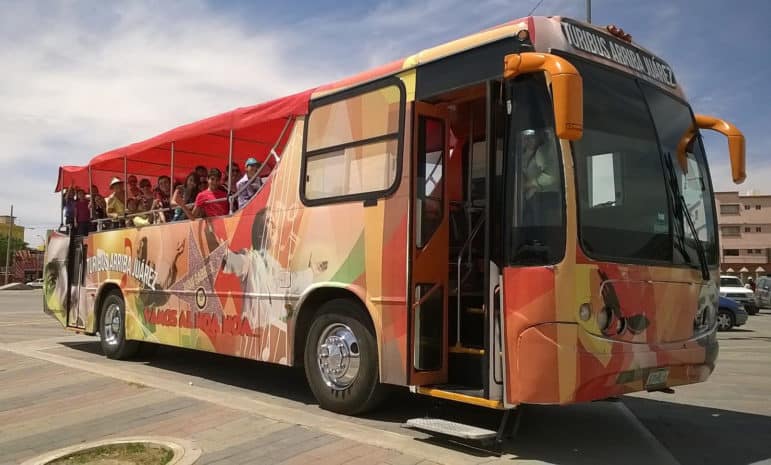
Courtesy photo
The Turibus Juárez, which some says is helping bring life back to the Juárez Market.
In many ways, the Juárez Market on Avenida 16 de Septiembre was the emblematic microcosm of the economic impact of violence and insecurity in Ciudad Juárez.
The once-thriving tourist destination on the edge of the city’s downtown was already suffering a historic decline when the hard ripples of 9-11 struck the borderland, triggering a U.S. security clampdown that led to three- or four-hour waits for people crossing back over to neighboring El Paso, Texas.
The violence of 2008-2012 was almost the nail in the coffin for the Juárez Market. For many years the sprawling indoor-outdoor venue of curios and candy stands, artesanías and typical Mexican-food eateries sported a desolate look, eking by in a ghost-like state virtually devoid of customers and staffed by scattered vendors and anxious-looking waiters hanging on by their fingertips.
So on a recent Sunday swing by the market, Frontera NorteSur was somewhat surprised to see most of the tables on the outdoor dining patio occupied by customers enjoying lunch.
“Now there are many tables,” said a satisfied Nelly Castillo, proprietor of the Apolo Café, one of several restaurants open for service at the Juárez Market. Castillo credited a good deal of the uptick in business to a bus parked on Avenida 16 de Septiembre, the Turibus Juárez.
Launched last May as a new and privately-owned tourism enterprise, the bus whisks visitors to several sites around the border city, including the Juárez Market, for a ticket price in pesos the equivalent of about six bucks. Roberto Cano, Turibus Juarez trip coordinator, said the company also offers special day-trips to Samalayuca, a rural Chihuahua town situated about 30 minutes from Juarez, for about $25.
The excursion includes a meal and tastings of sotol, an agave-sourced spirit commercialized in Samalayuca, Cano said.
In an interview with FNS, Cano said Turibus Juárez has attracted clients from Mexico, the United States, New Zealand, Australia and Germany. But the lion’s share of his company’s business, he explained, comes from U.S. immigration policies. The U.S. Consulate in Juárez is a mandatory stop for Mexican nationals from all over the country completing the bureaucratic procedures necessary for U.S. residence; many people pass days or even weeks in the city waiting for their proper papers.
For people with time on their hands, the Turibus Juárez beckons. “The majority of (customers) are from the consulate,” Cano said. “We go to the hotels and pick them up.”
Every 15 evenings, Turibus Juárez offers another special tour that includes the Juárez Market, he continued.
“We are telling people the myths and legends of Juárez,” Cano said about the evening jaunts to the market. “It’s a little dark, with ghosts… it’s completely dark and scary,” he added, with appropriate music to boot.
The young tourism specialist revealed that two of the myths and legends told to Turibus Juárez’s customers include “La Planchada,” a tale about a creepy nurse who kills kids in the hospital, and “El Loco Polis,” a story about a dead cop whose body contaminates a well underneath city hall from which people drink. “I know it’s gross, but people like it,” Cano laughed.
According to Cano, Turibus Juárez’s regular Tuesday-Sunday trips, escorted by English-speaking guides, leave from the strip mall where the Viva Mexico restaurant is located near the Bridge of the Americas — or the Free Bridge, as it is called in local parlance.
Besides the Juárez Market, the bus stops at the new Plaza de Mexicanidad and several museums, including the Casa de Adobe, the place where Mexican revolutionary and soon-to-be president Francisco Madero sought refuge during the Mexican Revolution more than a century ago.
Looking like the wise aunt of the kitchen, Nelly Castillo sounded relieved at the uptick in business at her Juárez Market restaurant.
“We sold very little, my husband and I,” Castillo said, recalling recent years when the world turned upside down. “We didn’t pay the gas, water or anything, because we couldn’t… we were struggling, struggling.”
Asked why she persisted, Castillo answered that she has 35 years invested with the café and resolved to remain with the familiar. “We said we’re going to stay here and we did. Thanks to God,” she added.
Although violence began declining after 2012, Castillo described 2013 and 2014 as still “difficult” years. This year, however, has been a much better one, the small restaurateur judged. “People are starting to come, not like before, but they are beginning to see things are okay.”
Almost across from the Juarez Market’s Café Apolo stands a rusted jewel of Juárez, the long-closed and crumbling Victoria Theater, now fenced off and reportedly slated for remodeling as part of the overall downtown development marshaled by the state and local governments that is proceeding in stages.
Castillo said she wasn’t privy to the particulars of the overall redevelopment plan, but contended that restoring confidence in would-be visitors is the real key to the recovery of the local downtown area economy.